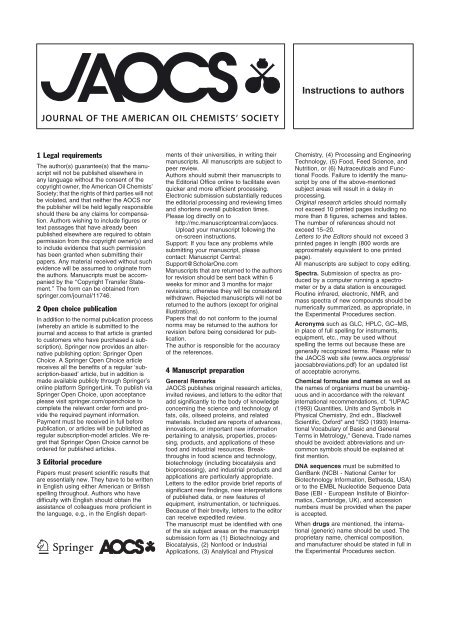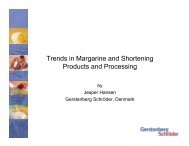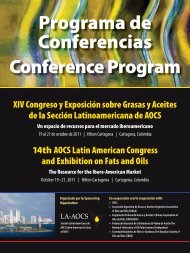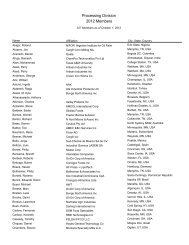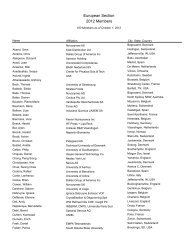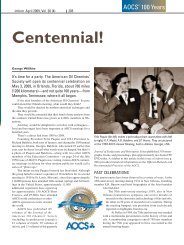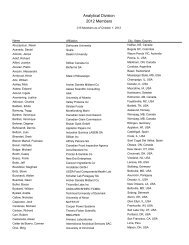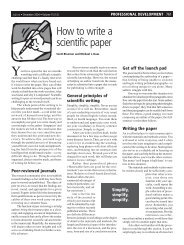JAOCS Author Guidelines - American Oil Chemists' Society
JAOCS Author Guidelines - American Oil Chemists' Society
JAOCS Author Guidelines - American Oil Chemists' Society
Create successful ePaper yourself
Turn your PDF publications into a flip-book with our unique Google optimized e-Paper software.
JOURNAL OF THE AMERICAN OIL CHEMISTS’ SOCIETY<br />
1 Legal requirements<br />
The author(s) guarantee(s) that the manuscript<br />
will not be published elsewhere in<br />
any language without the consent of the<br />
copyright owner, the <strong>American</strong> <strong>Oil</strong> Chemists’<br />
<strong>Society</strong>; that the rights of third parties will not<br />
be violated, and that neither the AOCS nor<br />
the publisher will be held legally responsible<br />
should there be any claims for compensation.<br />
<strong>Author</strong>s wishing to include figures or<br />
text passages that have already been<br />
published elsewhere are required to obtain<br />
permission from the copyright owner(s) and<br />
to include evidence that such permission<br />
has been granted when submitting their<br />
papers. Any material received without such<br />
evidence will be assumed to originate from<br />
the authors. Manuscripts must be accompanied<br />
by the ‘‘Copyright Transfer Statement.’’<br />
The form can be obtained from<br />
springer.com/journal/11746.<br />
2 Open choice publication<br />
In addition to the normal publication process<br />
(whereby an article is submitted to the<br />
journal and access to that article is granted<br />
to customers who have purchased a subscription),<br />
Springer now provides an alternative<br />
publishing option: Springer Open<br />
Choice. A Springer Open Choice article<br />
receives all the benefits of a regular ‘subscription-based’<br />
article, but in addition is<br />
made available publicly through Springer’s<br />
online platform SpringerLink. To publish via<br />
Springer Open Choice, upon acceptance<br />
please visit springer.com/openchoice to<br />
complete the relevant order form and provide<br />
the required payment information.<br />
Payment must be received in full before<br />
publication, or articles will be published as<br />
regular subscription-model articles. We regret<br />
that Springer Open Choice cannot be<br />
ordered for published articles.<br />
3 Editorial procedure<br />
Papers must present scientific results that<br />
are essentially new. They have to be written<br />
in English using either <strong>American</strong> or British<br />
spelling throughout. <strong>Author</strong>s who have<br />
difficulty with English should obtain the<br />
assistance of colleagues more proficient in<br />
the language, e.g., in the English depart-<br />
123<br />
ments of their universities, in writing their<br />
manuscripts. All manuscripts are subject to<br />
peer review.<br />
<strong>Author</strong>s should submit their manuscripts to<br />
the Editorial Office online to facilitate even<br />
quicker and more efficient processing.<br />
Electronic submission substantially reduces<br />
the editorial processing and reviewing times<br />
and shortens overall publication times.<br />
Please log directly on to<br />
http://mc.manuscriptcentral.com/jaocs.<br />
Upload your manuscript following the<br />
on-screen instructions.<br />
Support: If you face any problems while<br />
submitting your manuscript, please<br />
contact: Manuscript Central:<br />
Support@ScholarOne.com<br />
Manuscripts that are returned to the authors<br />
for revision should be sent back within 6<br />
weeks for minor and 3 months for major<br />
revisions; otherwise they will be considered<br />
withdrawn. Rejected manuscripts will not be<br />
returned to the authors (except for original<br />
illustrations).<br />
Papers that do not conform to the journal<br />
norms may be returned to the authors for<br />
revision before being considered for publication.<br />
The author is responsible for the accuracy<br />
of the references.<br />
4 Manuscript preparation<br />
General Remarks<br />
<strong>JAOCS</strong> publishes original research articles,<br />
invited reviews, and letters to the editor that<br />
add significantly to the body of knowledge<br />
concerning the science and technology of<br />
fats, oils, oilseed proteins, and related<br />
materials. Included are reports of advances,<br />
innovations, or important new information<br />
pertaining to analysis, properties, processing,<br />
products, and applications of these<br />
food and industrial resources. Breakthroughs<br />
in food science and technology,<br />
biotechnology (including biocatalysis and<br />
bioprocessing), and industrial products and<br />
applications are particularly appropriate.<br />
Letters to the editor provide brief reports of<br />
significant new findings, new interpretations<br />
of published data, or new features of<br />
equipment, instrumentation, or techniques.<br />
Because of their brevity, letters to the editor<br />
can receive expedited review.<br />
The manuscript must be identified with one<br />
of the six subject areas on the manuscript<br />
submission form as (1) Biotechnology and<br />
Biocatalysis, (2) Nonfood or Industrial<br />
Applications, (3) Analytical and Physical<br />
Instructions to authors<br />
Chemistry, (4) Processing and Engineering<br />
Technology, (5) Food, Feed Science, and<br />
Nutrition, or (6) Nutraceuticals and Functional<br />
Foods. Failure to identify the manuscript<br />
by one of the above-mentioned<br />
subject areas will result in a delay in<br />
processing.<br />
Original research articles should normally<br />
not exceed 10 printed pages including no<br />
more than 8 figures, schemes and tables.<br />
The number of references should not<br />
exceed 15–20.<br />
Letters to the Editors should not exceed 3<br />
printed pages in length (800 words are<br />
approximately equivalent to one printed<br />
page).<br />
All manuscripts are subject to copy editing.<br />
Spectra. Submission of spectra as produced<br />
by a computer running a spectrometer<br />
or by a data station is encouraged.<br />
Routine infrared, electronic, NMR, and<br />
mass spectra of new compounds should be<br />
numerically summarized, as appropriate, in<br />
the Experimental Procedures section.<br />
Acronyms such as GLC, HPLC, GC–MS,<br />
in place of full spelling for instruments,<br />
equipment, etc., may be used without<br />
spelling the terms out because these are<br />
generally recognized terms. Please refer to<br />
the <strong>JAOCS</strong> web site (www.aocs.org/press/<br />
jaocsabbreviations.pdf) for an updated list<br />
of acceptable acronyms.<br />
Chemical formulae and names as well as<br />
the names of organisms must be unambiguous<br />
and in accordance with the relevant<br />
international recommendations, cf. "IUPAC<br />
(1993) Quantities, Units and Symbols in<br />
Physical Chemistry, 2nd edn., Blackwell<br />
Scientific, Oxford" and "ISO (1993) International<br />
Vocabulary of Basic and General<br />
Terms in Metrology," Geneva. Trade names<br />
should be avoided: abbreviations and uncommon<br />
symbols should be explained at<br />
first mention.<br />
DNA sequences must be submitted to<br />
GenBank (NCBI - National Center for<br />
Biotechnology Information, Bethesda, USA)<br />
or to the EMBL Nucleotide Sequence Data<br />
Base (EBI - European Institute of Bioinformatics,<br />
Cambridge, UK), and accession<br />
numbers must be provided when the paper<br />
is accepted.<br />
When drugs are mentioned, the international<br />
(generic) name should be used. The<br />
proprietary name, chemical composition,<br />
and manufacturer should be stated in full in<br />
the Experimental Procedures section.
Genus and species names should be in<br />
italics. The common names of animals<br />
should not be capitalized.<br />
Units and abbreviations. Please adhere to<br />
internationally agreed standards such as<br />
those adopted by the commission of the<br />
International Union of Pure and Applied<br />
Physics (IUPAP) or defined by the International<br />
Organization of Standardization<br />
(ISO). Metric SI units should be used<br />
throughout except where non-SI units are<br />
more common [e.g. liter (I) for volume].<br />
Names of instruments and equipment,<br />
and their manufacturers, no longer need to<br />
be noted in the Experimental Procedures<br />
section. However, sources of chemicals,<br />
columns, packing materials, and the like<br />
should be included, along with locations of<br />
these suppliers.<br />
Title Page<br />
The title page should include:<br />
– The name(s) of the author(s) (an asterisk<br />
indicates the corresponding author)<br />
– A concise and informative title (limited to<br />
100 characters)<br />
– The affiliation(s) and address(es) of the<br />
author(s)<br />
– The e-mail address, telephone, and fax<br />
numbers of the corresponding author<br />
Abstract<br />
Maximal length of the abstract is 200 words;<br />
no literature references should be contained<br />
in the abstract. The abstract should briefly<br />
state the objective and approach and give a<br />
succinct summary of results and major<br />
conclusions drawn. Emphasis should be on<br />
what was found, not what was done. Letters<br />
to the Editors should be preceded by a short<br />
abstract (no more than 100 words).<br />
Key words<br />
Up to 10 key words that describe the<br />
subject matter of their paper should be<br />
supplied after the Abstract for indexing<br />
purposes. Within the Online Submission<br />
system authors are asked additionally to<br />
select key words from a key word list.<br />
These key words are not printed but used<br />
only for matching reviewers from the<br />
reviewer database.<br />
Abbreviations should be defined at first<br />
mention in the abstract and again in the<br />
main body of the text and used consistently<br />
thereafter (see also Scientific Style and<br />
Format: The CBE Manual for <strong>Author</strong>s,<br />
Editors and Publishers, 6th edn., Cambridge<br />
University Press, Cambridge, UK,<br />
1994). The formal name and EC number of<br />
enzymes are used at first mention, and the<br />
trivial name can be used subsequently, if<br />
more convenient.<br />
A list of symbols should follow the abstract<br />
if such a list is needed. Symbols must be<br />
written clearly. The international system of<br />
units (SI units) should be used.<br />
Essential footnotes to the text should be<br />
numbered consecutively and placed at the<br />
bottom of the page to which they refer.<br />
The Introduction should state the purpose<br />
of the investigation and give a short review<br />
of the pertinent literature. It should be<br />
limited to identifying the gap in scientific<br />
knowledge or the problem that the research<br />
addressed. No more than 8–10 references<br />
should need to be cited.<br />
Experimental Procedures. Sufficient detail<br />
or literature references to such methods<br />
should be included in the<br />
Experimental Procedures section to permit<br />
other scientists to repeat or extend the<br />
experiments. This section should also<br />
contain an overview of the experimental<br />
approach used, especially in the case of<br />
complex or unusual designs. Data should<br />
not be reported to more significant figures<br />
than justified by the experimental procedures<br />
used.<br />
The Results and Discussion section<br />
should describe the outcomes of the study<br />
and how these respond to the gap or<br />
problem identified in the introduction. Data<br />
should be presented as concisely as possible,<br />
if appropriate in the form of tables or<br />
figures, although very large tables should<br />
be avoided. No statement of planned future<br />
research or publication is allowed. No<br />
separate conclusions or summary section<br />
or paragraph is used. Include such conclusions<br />
in the abstract.<br />
Acknowledgements. These should be as<br />
brief as possible. Any grant that requires<br />
acknowledgement should be mentioned.<br />
The names of funding organizations should<br />
be written in full.<br />
Funding. <strong>Author</strong>s are expected to disclose<br />
any commercial or other associations that<br />
might pose a conflict of interest in connection<br />
with submitted material. All funding<br />
sources supporting the work and institutional<br />
or corporate affiliations of the authors<br />
should be acknowledged.<br />
References. The list of references should<br />
include only works that are cited in the text<br />
and that have been published or accepted<br />
for publication. ‘‘Personal communications’’<br />
or ‘‘Unpublished data’’ should only be<br />
mentioned in the text.<br />
If available the Digital Object Identifier (DOI)<br />
can be added at the end of the reference in<br />
question.<br />
Example:<br />
Ward J, Robinson PJ (2004) How to detect<br />
hepatocellular carcinoma in cirrhosis. Eur<br />
Radiol 14: 29–36. DOI 10.1007/s00330-<br />
004-1450-y<br />
A paper published online but not yet in print<br />
can be cited using the DOI:<br />
Ward J, Robinson PJ (2004) How to detect<br />
hepatocellular carcinoma in cirrhosis. Eur<br />
Radiol DOI 10.1007/s00330-004-1450-y<br />
References should be numbered in the<br />
order in which they appear in the text and<br />
listed in numerical order. Journal titles<br />
should be abbreviated according to CASSI<br />
(Chemical Abstracts Service Source Index).<br />
References with correct punctuation should<br />
be styled as follows:<br />
Journal articles<br />
Nelson LA, Foglia TA, Marmer WN (1996)<br />
Lipase-Catalyzed Production of Biodiesel.<br />
J Am <strong>Oil</strong> Chem Soc 73:1191–1195<br />
Books<br />
Firestone D (2006) Physical and Chemical<br />
Characteristics of <strong>Oil</strong>s, Fats and Waxes,<br />
2nd edn. AOCS Press, Champaign<br />
Multiauthor books<br />
Gunstone FD (1986) Chemical Properties.<br />
In: Gunstone FD, Harwood JL (eds) The<br />
Lipid Handbook. Chapman & Hall, London,<br />
pp 449–484<br />
Patents<br />
Karnofsky GB, Hansotte RJ (1982) Process<br />
for Extracting Oleaginous Seed Materials.<br />
Particularly Cottonseed with Aqueous Alcohol.<br />
U.S. Patent 4,359,417<br />
Webpage<br />
National Institute of Health (accessed Jan.<br />
2003) Menopausal Hormone Therapy.<br />
http://www.nih.gov/PHTindex.htm<br />
Illustrations and Tables<br />
All figures (photographs, graphs, or<br />
diagrams) and tables should be cited in the<br />
text, and each numbered consecutively<br />
throughout. Lowercase letters (a, b, etc.)<br />
should be used to identify figure parts. If<br />
illustrations are supplied with uppercase<br />
labeling, lowercase letters will still be used<br />
in the figure legends and citations.<br />
Size of figures. The figures should either<br />
match the width of the column (8.6 cm) or<br />
be 13.1 cm or 17.6 cm wide. The maximum<br />
length is 23.6 cm.<br />
Figure legends must be brief, self-sufficient<br />
explanations of the illustrations. The<br />
legends should be placed at the end of the<br />
text.<br />
Online publication of color illustrations is<br />
free of charge. For color in the print version,<br />
authors will be expected to make a contribution<br />
(a 950, US$ 1150, plus 19% VAT)<br />
toward the extra costs, irrespective of the<br />
number of color figures.<br />
Tables should have a title and a legend<br />
explaining any abbreviation used in that<br />
table. Footnotes to tables should be<br />
indicated by superscript lowercase letters<br />
(or asterisks for significance values and<br />
other statistical data).<br />
Equation<br />
Equations should be numbered sequentially<br />
by Arabic numbers in parentheses. The<br />
words ‘‘equation’’ and ‘‘equations’’ should<br />
be abbreviated Eq. and Eqs., followed by<br />
the number except at the beginning of a<br />
sentence.<br />
5 Technical instructions for preparing<br />
your manuscript<br />
Text and figures must be sent as separate<br />
files.<br />
Text<br />
1. Use a normal, plain font (e.g., Times<br />
Roman) for text. Other style options:<br />
– for textual emphasis use italic types.<br />
– for special purposes, such as for<br />
mathematical vectors, use boldface<br />
type.<br />
2. Use the automatic page numbering<br />
function to number the pages.
3. Do not use field functions.<br />
4. For indents use tab stops or other<br />
commands, not the space bar.<br />
5. Use the table functions of your word<br />
processing program, not spreadsheets,<br />
to make tables.<br />
6. Use the equation editor of your word<br />
processing program or MathType for<br />
equations.<br />
7. Place any figure legends or tables at the<br />
end of the article.<br />
8. Submit all figures as separate files and<br />
do not integrate them within the text.<br />
Data formats<br />
Springer offers a template that can be used<br />
with Word 2000 and higher versions at<br />
Springer.com. See: Our services for:<br />
<strong>Author</strong>s<br />
Text:<br />
Save as: RTF (Rich Text Format) or<br />
Microsoft Word compatible formats<br />
Figures:<br />
EPS or TIFF.<br />
Illustrations<br />
The preferred figure formats are EPS for<br />
vector graphics exported from a drawing<br />
program and TIFF for halftone illustrations.<br />
EPS files must always contain a preview in<br />
TIFF of the figure. The file name (one file for<br />
each figure) should include the figure<br />
number. Figure legends should be included<br />
in the text at the end and not in the figure<br />
file.<br />
• Scan resolution: Scanned line drawings<br />
should be digitized with a minimum<br />
resolution of 1200 dpi relative to the final<br />
figure size. For digital halftones, 300 dpi is<br />
usually sufficient.<br />
• Color illustrations: Store color illustrations<br />
as RGB (8 bits per channel) in TIFF<br />
format.<br />
• Vector graphics: Fonts used in the vector<br />
graphics must be embedded. Please do<br />
not draw with hairlines. The minimum line<br />
width is 0.2 mm (i.e., 0.567 pt) relative to<br />
the final size.<br />
6 Electronic supplementary material<br />
Electronic supplementary material (ESM)<br />
for an article in the journal will be published<br />
in SpringerLink provided the material is:<br />
– submitted to the Editor(s) in electronic<br />
form together with the paper and is<br />
subject to peer review,<br />
– accepted by the journal’s Editor(s).<br />
ESM may consist of<br />
– information that cannot be printed:<br />
animations, video clips, sound recordings<br />
– information that is more convenient in<br />
electronic form: sequences, spectral<br />
data, etc.<br />
– large original data that relate to the<br />
paper, e.g. additional tables, illustrations<br />
(color and black & white), etc.<br />
After acceptance by the journal’s Editor(s)<br />
ESM will be published as received from the<br />
author in the online version only. Reference<br />
will be given in the printed version.<br />
7 Proofreading<br />
<strong>Author</strong>s should make their proof corrections<br />
on a printout of the PDF file or use<br />
the online correction facilities provided<br />
with the proof. They should check that the<br />
text is complete and that all figures and<br />
tables are included.<br />
After online publication, further changes<br />
can only be made in the form of an<br />
Erratum, which will be hyperlinked to the<br />
article.<br />
The author is entitled to formal corrections<br />
only. Substantial changes in content,<br />
e.g. new results, corrected values,<br />
title, and authorship are not allowed<br />
without the approval of the responsible<br />
editor. In such a case please contact the<br />
Editorial Office before returning the<br />
proofs to the publisher.<br />
8 Offprints, Free copy<br />
One complimentary copy is supplied free of<br />
charge. Orders for offprints can be placed<br />
by returning the order form with the corrected<br />
proofs.
http://www.springer.com/journal/11746


